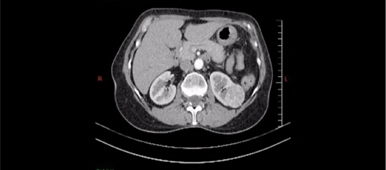Procedure: Robot-assisted laparoscopic PN
A prospective comparison of surgical and pathological outcomes obtained after robot-assisted or pure laparoscopic partial nephrectomy in moderate to complex renal tumours: results from a French multicentre collaborative study
Alexandra Masson-Lecomte1,2,3, Karim Bensalah5,6, Elise Seringe2,3, Christophe Vaessen1,2, Alexandre de la Taille4,7, Nicolas Doumerc8,9, Pascal Rischmann8,9, Franck Bruyère10,11, Laurent Soustelle12,13, Stéphane Droupy12,13 and Morgan Rouprêt1,2
1Department of Urology, Pitié Salpétrière, Assistance Publique – Hôpitaux de Paris, Paris, 2Université Paris 6, Paris, 3Department of Statistics, Pitié Salpétrière, Assistance Publique – Hôpitaux de Paris, Paris, 4Department of Urology, Henri Mondor, Assistance Publique – Hôpitaux de Paris, Paris, 5Department of Urology, CHU de Reims, Reims, 6Université de Reims Champagnes-Ardenne, Marne, 7Université Paris-Est Creteil, Marne, 8Department of Urology, CHU Rangueil, Toulouse, 9Université Toulouse 3, Toulouse, 10Department of Urology, CHU Bretonneau, Tours, 11Université François-Rabelais, Tours, 12Department of Urology, CHU Caremeau, Nimes, 13Université Montpellier 1, Montpellier, France
OBJECTIVE
• To prospectively compare the surgical and pathological outcomes obtained with robot-assisted laparoscopic partial nephrectomy (RAPN) or laparoscopic PN (LPN) for renal cell carcinoma in a multicentre cohort.
PATIENTS AND METHODS
• Between 2007 and 2011, 265 nephron-sparing surgeries were performed at six French urology departments. The patients underwent either RAPN (n = 220) or LPN (n = 45) procedures.
• The operative data included operative duration, warm ischaemia time (WIT) and estimated blood loss (EBL). The postoperative outcomes included length of stay (LOS), creatinine variation (Modification of Diet in Renal Disease group), Clavien complications and pathological results.
• The complexity of the renal tumour was classified using the R.E.N.A.L. nephrometry scoring system. Student’s t-test and chi-squared tests were used to compare variables.
RESULTS
• The median follow-ups for the RAPN and LPN groups were 7 and 18 months, respectively (P < 0.001).
• Age and American Society of Anesthesiology score were significantly higher in the LPN group (P = 0.02 and P = 0.004, respectively).
• These variables were lower in the RAPN group: WIT [mean (SD) 20.4 (9.7) vs 24.3 (15.2) min; P = 0.03], operative duration [mean (SD) 168.1 (55.5) vs 199.7 (51.2) min; P < 0.001], operating room occupation time [mean (SD) 248.3 (66.7) vs 278.2 (71.3) min; P = 0.008], EBL [mean (SD) 244.8 (365.4) vs 268.3 (244.9) mL; P = 0.01], use of haemostatic agents [used in 78% of RAPNs and 100% of LPNs; P < 0.001] and LOS [mean (SD) 5.5 (4.3) vs 6.8 (3.2) days; P = 0.05).
• There were no significant differences between pre- and postoperative creatinine levels, pathology report or complication rates between the groups. The main limitation was due to the study’s non-randomised design.
CONCLUSION
• RAPN is not inferior to pure LPN for perioperative outcomes (i.e. EBL, operative duration, WIT, LOS). Only a randomised study with a longer follow-up can now provide further insight into oncological outcomes.

